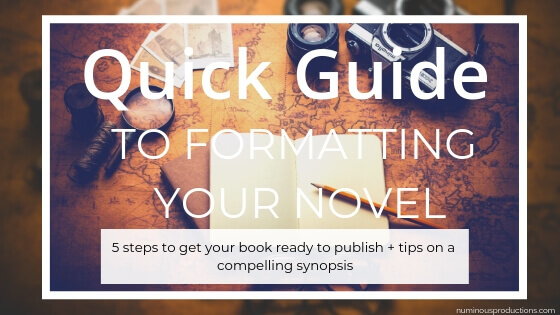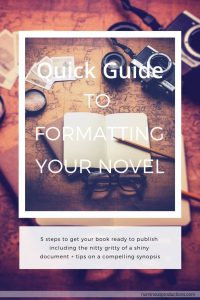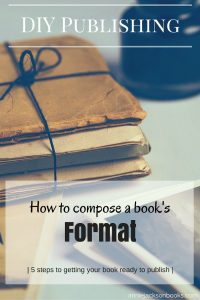When most people think about DIY publishing, formatting the ebook is possibly the biggest void they’re unsure of. It’s actually a lot simpler than you might expect (sooo much easier than formatting your paperback), but kinda boring to discuss.
For the most part, formatting your ebook is removing formatting more than anything else. Because in the end, you have very little control over almost everything in an ebook. Each app has its own built in fonts. Every device size is going to lay out the text differently. Readers can also choose their preferred options for text size, font, and other details.
So, the goal is to get your document to the simplest version possible, with only a few necessary style controls (for things like section headings). Then there are different software options that will easily create the ebook files for you.
Strip it down
The easiest way to begin is to get rid of anything extraneous. This can happen if you upload your document to something like Google Drive to share it with an editor or beta reader. That can introduce unnecessary web formatting styles that then interfere with how your ebook looks. If you use strikethroughs or different color fonts for editing these can linger and then show up in unexpected ways. And sometimes weird styles and characters are simply end up as part of your document.
Character Review
Quick formatting note – details are for Word on a PC. The steps are the same if you’re using different software or a MAC but you may have to search for exactly how to accomplish them.
Turn on the Show Characters option to see every paragraph return, space, line break, everything. You’re going to skim through the text (probably a few times) looking for a few things:
- Odd Characters. Remove any you don’t recognize or you don’t want. These are most likely if you’ve used Google Docs or OneDrive or other cloud-based software with your editors or beta readers.
- Consistency in character, paragraph and page spacing.
- Do you have two spaces after sentences? Use Alt+E+E to find 2 spaces and replace them with 1.
- Check for two spaces after question marks and fix those.
- And exclamation points.
- And commas so they have a single space after them.
- Now look at your paragraphs to see if they have one or two hard returns afterward. You only want 1, if you want more space use styles in the next section to create it.
- Are your apostrophes and quote marks curved or straight? Straight is better (so you don’t end up with something curved the wrong way). You may have to make adjustments in your Options so that Word doesn’t automatically use Smart Quotes. Then use Alt+E+E to replace all your apostrophes and all your quotes.
- Also look for the number of hard returns you have between each chapter/section before and after the page breaks (don’t use line breaks (Shift+Enter) – use hard returns.
There isn’t a right or wrong count of hard returns to use, though you rarely want more than 2 before or after any text or page break. The most important thing is that it’s the same count each time.
- Replace tabs with an indent defined in your styles below.
Paragraph Formatting
There are basically two choices with paragraphs: indent or block.
Not sure which to use? Open up some of your favorite ebooks and see how they do it. Mostly likely if it’s fiction you’ll see paragraph indent with no extra line break between paragraphs.
If you’re going with block text, then you want space between each paragraph.
The below assumes you’re using indented paragraphs. If you’re using block text instead, it’ll save you a few steps and you should be able to see which parts to ignore.
Styles
You want to use styles to define any text formatting (like italics or larger font or paragraph spaces and indent). Two pieces of text may look visually the same but have two different styles. Sometimes those different styles will actually make the text look different on an ereader. So the first step is to trim down your style list to only the essentials.
You can review/edit styles on the Home tab or you can click the little pop out icon at the bottom right of the Styles section. This will show you a list of all styles used in the document. It’ll show you what style is used based on where your cursor is. And you can modify the styles by clicking the arrow on the right of each style.
- Normal
- Choose Modify. Click Format at the bottom of the pop up and then choose Paragraph. In the Indentation section, set the Special dropdown to First line by .2. Also in the Spacing section set both Before and After to 0 pt. Finally, set Line spacing to Single.
- Use a font like Georgia. It doesn’t make much difference which you choose since ebook apps will have their own built-in fonts but Georgia is a nice base. 12 pt. Justified.
- You’ll likely have variations of Normal such as Normal+Italics already in the document for places where you’ve used italics or bold. Review these variations to make sure they match your definition of Normal.
- Heading 1 – this will influence your Table of Contents so only use this style on Chapters and Sections you want in your TOC (see Front and Back Matter for more info on which sections you may want)
- Choose Modify. Center the text. Select a larger font size than Normal (something like 18 pt – 24 pt).
- You may also want to add some space after your chapter heading (possibly 2-3 lines). Either use hard returns or click Format then Paragraph and add space in After (possibly 24 pt).
- Chapter Paragraph – for the first paragraph in each chapter
- Create a new style (button at the bottom of the style pop out box). If the “Style based on” drop down has Normal selected then the new style will default to those settings.
- Click Format and choose Paragraph. In the Indentation section, change the Special drop down to (none).
You also want to get a bit fancy by making the entire first line uppercase (but remember the length of the first line will vary by device) or maybe make the first five words uppercase or just the first word.
Or maybe you want to go a different direction and make the first letter or first word bold.
- All other settings should stay the same as Normal.
- Centered – for section breaks within a chapter or Normal text that needs to be centered. Without this separate style then ‘centered’ text will actually be off-center since it will inherit the first line indentation set for Normal.
- Create a new style based on Chapter Paragraph. Align Center.
- Copyright.
- Create new style based on Centered. Font size smaller (such as 10 pt).
- Sub-heading – useful for text in your Front or Back Matter that you want slightly larger and possibly centered but don’t want in your TOC. Or use for Chapter numbers/titles if you only want one of the two in your Table of Contents.
- Create new style based on Centered. Increase the font size (such as 14 pt)
Read through the list of styles you have and check out any that seem odd, redundant or unnecessary. When you remove those extra styles the text usually reverts to Normal which is probably what you want.
Now for the hard part. Once your style list is defined, go through your document and assign the appropriate style to your text.
While you’re at it, insert a page break between each section if you haven’t already.
And for your chapters, make sure everything is standard (if your using numbers and titles or if you have a few asterix (*) or tilde (~) beneath the chapter number. Or between the chapter number and title.
Special Formatting
A few notes on formatting or the Front and Back Matter since they’re generally different than the body of your narrative.
Title Page
Start with your ebook formatting. Even though it’ll be different than your paperback it’s a good base to start from.
- Enter a space or two at the top to create some breathing room.
- Then your title.
- Then a paragraph return or two and your name, probably in your book font.
- And then three or four paragraph returns and the name of your publishing company, probably in a smaller font and a logo if you have one.
Dedication
Formatting for the dedication is pretty standard. You want one space at the top (again for breathing room) then the text is centered (using your Centered style) and italics.
You have more options with a paperback format when it comes to interior design with images and fanciful chapter openings because you have more control of the end result. Remember with an ebook you want to keep it as simple as possible.
Other Books By
If you want to get really fancy you can use a different font for different book series, especially if some of them are in different genres (probably something as simple as some are serif and other book titles are sans serif).



